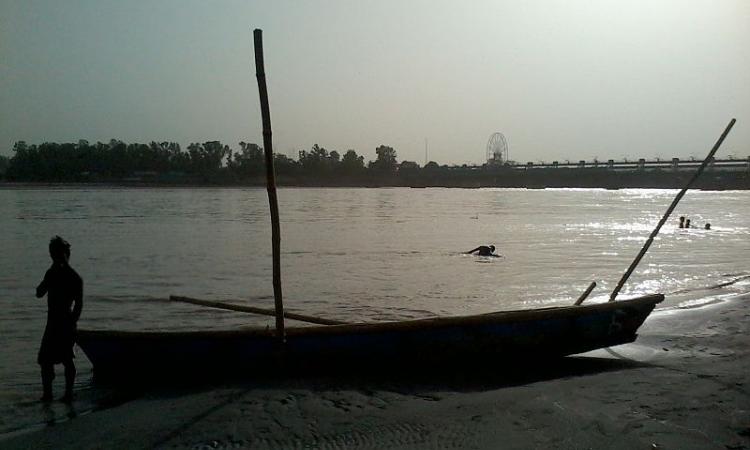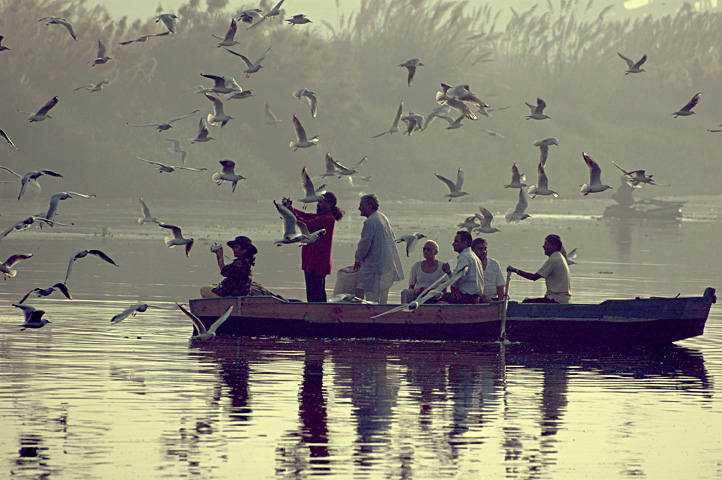
Sarla Yadav, a resident of Yamuna Ghat 24 is a treasure trove of stories on the river Yamuna. She runs a boat business with her son Shyam who provides a nuanced personal account of living by the river and of eking out a meagre livelihood by plying boats. They are among a few families who have not sold their boats so far.
Shyam says their business suffered due to the ever-rising pollution—ferries are rare, so are the fairs by the river and swimming competitions. He shifts from one job to the other, sometimes construction work and other times, shopkeeping. On the eastern bank, one can see that pieces of land have been leased out on the river’s floodplains to grow vegetables. The vegetable growers too have a similar story to tell.
“The river has been reduced to a sluggish sewage-laden channel and there’s filth floating along the edges of the bustling Nigambodh ghat on the Yamuna. The river cleanses itself once a year when it swells due to the heavy monsoon rains in its catchment,” says Sarla speaking at an event Revitalising Yamuna: Alternate imaginations held on May 11, 2019 by the Tata Centre for Development at UChicago in collaboration with the Centre for Community Knowledge, Ambedkar University, Delhi.
The event comprised a series of activities such as photo exhibition, screening of a documentary and a panel discussion on Connections and disconnections between the river and the residents of the city. The photo exhibition recorded people’s memories and experiences of the river, the changes happened to it through the decades, human engagements with the river and its future. The Centre for Community Knowledge at the Ambedkar University has been documenting memories, people’s voices and experiences of the Yamuna river under their project: The river and the city. Their stories are woven together into a 30-minute documentary that brought forth the realities of various riverine communities. For example, there is a segment on young children who, for a livelihood, dive into the river to retrieve coins thrown into the water by pilgrims and the impact of the shrinking river on them.
Changes in the river
The panel discussion, moderated by Surajit Sarkar, assistant professor at Ambedkar University, had Neha Sinha, wildlife conservationist associated with the Bombay Natural History Society, Prof. Reema Bhatia and Prof. Meeta Kumar of Miranda House and Bhim Singh Rawat of South Asia Network on Dams, Rivers and People (SANDRP) and Yamuna Jiye Abhiyaan and representatives of the communities living along the Yamuna. It deliberated on the changes observed in the river over the years and encouraged individuals and communities to reconnect with it.
With no freshwater flowing in it for the most part of the year, the people inhabiting the Yamuna’s banks are dismayed by the loss of aquatic life and the fetid river bed. Sarla claims that doctors nowadays advise people against taking a dip in the river that once attracted lakhs of pilgrims for the customary holy dip. “People like us whose livelihoods are dependent on the river are affected the most,” said Sarla, speaking at the panel.

“Huge barrages and hydropower plants in the upstream reaches of the river are inhibiting its flow. This, along with encroachments on the flood plains, the discharge of untreated sewage water and release of pollutants from agriculture and industry, is killing the Yamuna. Without restoring the flow of the river, there is no solution in sight,” says Bhim Singh Rawat.
The Yamuna Action Plans, in the last 23 years, have focused on the setting of the sewage treatment plants rather than restoring the river flow and the habitat. “Delhi does not need water from newer dams upstream especially since the existing dams on the Yamuna are performing far from optimally,” says Rawat.
Early this year, the Supreme Court had expressed concern over the condition of the Yamuna and has entrusted the task of monitoring government efforts to clean the Yamuna to the National Green Tribunal.
A city indifferent to the river
Speaking at the event, Meeta Kumar who has done research on the social ecology of the Yamuna said that the city that is so obviously dependant on the river has turned its back to it for several decades now. “The Yamuna runs through the city, yet it is quite peripheral to our day-to-day conscious existence. The river turned putrid as far back as in the 1950s, yet there was a lack of public demand for a cleaner Yamuna and public action was sparse," says Kumar.
Kumar, along with her co-researcher Prof. Reema Bhatia, tried to study the dynamics of the relationship between the Yamuna and Delhi. They looked at communities closest to the river, specifically, the villages of Jagatpur and Madanpur Khadar (South Delhi) and found the interplay of change and continuity in these villages interesting. Bhatia said that the approach of the state to the river was apathetic considering that it had granted permission to hold certain mega cultural events on the floodplains recently.
“A river is a shared property and this has unintended consequences on the river. In the absence of appropriate regulation, it is likely to be overused and be subjected to the tragedy of the commons, wherein individual users act as per their own self-interest and not for the common good of all users. This results in the depletion or spoiling of shared resources like the Yamuna. In the case of Delhi, the city’s growth did not translate to a new set of rules or institutions that governed the riverine resources so that both the city and the river could sustain,” says Kumar.
Every year, with the onset of winter, migratory birds flock the city. They come into the Yamuna floodplains and other water bodies and wetlands. “If restored, the Yamuna has a great potential to rebound as a natural entity,” says Neha Sinha.
UChicago, in collaboration with the Young India Fellows at Ashoka University, had conducted a four-month-long field study to understand the impact of river pollution on health and livelihood of communities living on the banks of the Yamuna in Delhi. “The social investigations revealed some interesting facts about the city-river disconnect. A strong correlation was found between the data on water quality collected by UChicago with the ground reality,” said Dr. Nutan Maurya, Environmental Anthropologist, Tata Centre for Development, University of Chicago, Delhi Centre.